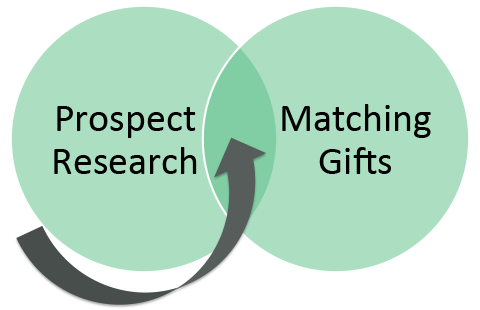Incorporate Matching Gifts Into Your Prospect Research
If prospect research is the eyes that spot the prospects then matching gifts are the hands that grab the donations. Of course, you can receive gifts without doubled donations, but you shouldn’t let easy money slip through your grasp. Prospect research can unveil a world of new prospects, and matching gifts allow you to maximize those generous gifts.
Matching Gift Basics
Matching gift programs are charitable giving programs run by corporations in which the companies match employee donations to eligible nonprofit organizations.
For example, if a donor works for Bank of America and donates $250 to a K-12 school, university, or 501(c)(3) organization, Bank of America will “double the donation” by writing a check for $250 to the same nonprofit.
Learn more about the basics of matching gifts >
Prospect Research Basics
Prospect research educates your organization about donors and potential donors, so you may evaluate an individual’s potential to support a specific nonprofit. Data is the key to allocating your limited resources such that you generate the largest ROI for your nonprofit organization.
Consider this example from Ryan Woroniecki:
“A donor with major giving potential may have given an average-sized gift to a crowdfunding campaign (say, $50). This donor may be willing to give a lot more to your nonprofit but hasn’t so far because crowdfunding campaigns generally ask for smaller donations.
If you base your appeal on their current giving, rather than their potential, you may ask for a gift in the same range ($50 – $70). A donor isn’t likely to give a gift that’s significantly larger than what you ask for. As such, you’d be leaving hundreds, even thousands, of dollars on the table simply because you didn’t ask for more.”
Missed opportunities like the example above are the exact reason why it is crucial that organizations take the time to examine their donor pool. With the help of prospect research, you’ll be able to sift through your donor database and segment supporters based on giving potential.
A variety of information is examined when conducting proper prospect research. This includes:
- Previous donations to your nonprofit – Who has donated to your nonprofit? How often do these people donate? How much do they give?
- Donations to other nonprofits – Where else does the prospect make philanthropic contributions?
- Political giving – Does the prospect donate to political campaigns?
- Nonprofit involvement – Is the prospect a board member for other nonprofits?
- Real estate ownership – If the prospect owns real estate, what is the value of that property?
- Business affiliations – What does the prospect do for a living? Is he involved in subsidiary ventures or corporate boards?
- Securities and Exchange Commission (SEC) insider stock transactions – In what companies and how heavily does the prospect invest?
- Personal information – Hit the basics: contact information, marital status, and personal interests.
This prospect research data provides valuable fundraising benefits, such as:
- Refines major gift prospect outreach – Your hardworking staff only has so much time. With prospect screening, your organization can quickly prioritize outreach efforts to donors according to their affinities for your nonprofit and their capacities to give. This permits staff to focus more of their efforts on bonding with major donors.
- Converts annual fund donors into major gift prospects — With the time you’re not spending on prospect research, your team can focus on donors who can or have made large charitable donations.
- Identifies planned or deferred giving prospects – If planned giving is not one of your strong suits, prospect screening reveals solid candidates for bequests.
- Generates new prospects – Donation lists from other nonprofits and colleagues of your existing major gift donors are great places to discover new prospects.
- Analyzes donor giving patterns – Donors, as well as their families and foundations, support various causes. You can see what organizations they support and unearth donation patterns.
- Optimizes ongoing fundraising opportunities – Hospitals, universities, and similar organizations experience constant influxes of potential donors. Prospect screening enables your staff to pinpoint potential donors and individually tailor pitches.
Learn more about Prospect Research with DonorSearch’s ultimate guide to Prospect Research >
Multiply Prospects’ Potential with Matching Gifts:
With over 65% of Fortune 500 companies offering employee matching gift programs, there is potential to use matching gifts to turn even the smallest gifts into bigger donations. Major gift donors become even more important when they have the potential to give twice as much thanks to corporate matching gift programs.
A key insight of prospect research is the potential donors’ business affiliations, such as where they work and where their spouses work. Perhaps the individual’s spouse works for a company such as GE, which will match donations up to $50,000. If this spouse has the potential to give then she shoots to the top of the potential donors list.
Not only do matching gifts present the opportunity to increase gifts, but, when combined with prospect research, you can identify more sources of doubled donations.
Four Key Prospect Research & Matching Gift Statistics:
- More than 65% of Fortune 500 companies offer matching gift programs — Matching gifts represent an easy way for donors to multiply the impacts of their donations. The best part is that matching gifts don’t cost the prospect any additional money and they only take five minutes to submit. Many smaller employers offer matching gift programs, too, so use prospect screening to identify if prospects work for such companies and remind them of matching gift opportunities.
- Matching gift participation rates range from 3% to 65% depending on how widely a company promotes matching gifts to its employees — Companies must share vast amounts of business, personal, and charitable giving information with employees without overwhelming them. It should come as no surprise that many employees have no idea if their company offers a matching gift program or how to submit a match.
- An estimated $6-$10 billion in matching gift funds goes unclaimed per year — Because matching gift participation rates are low across companies and industries, nonprofits miss out on substantial amounts of donations. Incorporating matching gift information into your conversations with high quality prospects will help close the gap for your nonprofit.
- Mentioning matching gifts in fundraising appeals results in a 71% increase in the response rate and a 51% increase in the average donation amount (prior to receiving any matching gift funds) — Did you know that highlighting a prospect’s matching gift eligibility results in an increased likelihood that he or she will make a donation? Even better, when they do donate, they’ll likely give a larger amount than if there wasn’t a match available. Empower your prospect researchers to include matching gift information in their asks as a method for helping them to secure a major gift.
View additional matching gift statistics >











